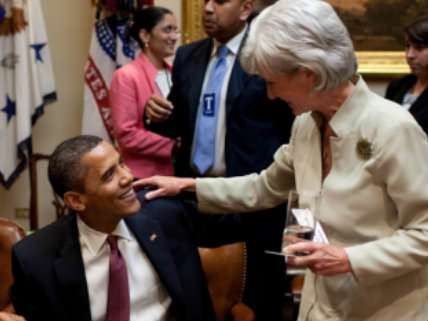Obamacare Sign-Ups Beat January Enrollment Projections, But Total Enrollment Still Falls Short

Obamacare supporters seemed rather pleased with yesterday's enrollment figures. More than 1.1 million people signed up for private plans in January, making it the first month to beat early enrollment projections.
According to administration figures, 1.14 million people signed up for private health plans through the law's exchanges last month, a little more than the 1.059 million that had been projected.
But overall sign-up totals for private insurance, which now stand at 3.3 million nationwide, still lag behind early enrollment projections by about 1.1 million.
Even with January's above-target sign-up count, it's still going to be quite difficult for the administration to meet its initial enrollment target of 7 million people by the end of open enrollment in March. In order to hit that target, the administration would need to get more people to enroll over the next two months than signed up in the first four months.
Enrollment is already slowing dramatically from its December peak. January sign-ups were above target for the first month of the year, but still down by about 49 percent from December. That pace probably won't pick up significantly in February, which means that whatever enrollment surge we see in March (the final month for 2014 enrollment) will have to be quite large.
All this assumes that basically all of the "sign-ups" the administration is reporting eventually convert into paid enrollments. But that seems unlikely. Because most exchanges aren't handling or tracking premium payments themselves yet, it's hard to get a complete picture of how many people have paid their first premium, which is necessary for enrollment. But insurance industry officials and well-connected sources say that only about 70-80 percent of sign-ups have actually paid so far. And in Washington state, which is tracking payment rates, only about half of sign-ups have resulted in payment so far.
The health law's supporters have taken to arguing that total enrollment matters less than the demographic mix. (Insurance pools need a significant proportion of younger, healthier individuals to balance out the higher health costs of older and sicker enrollees.) But the administration's early targets look increasingly difficult to meet there as well. The goal had been for about 39 percent of sign-ups to be between the ages of 18 to 34. The latest figures show that just 25 percent of sign ups so far fall in that age cohort.
The administration and insurers have marketing campaigns in the works. But they seem to be about as well planned as the rest of Obamacare's rollout. Early plans for door-to-door outreach were scrapped, and Obamacare's enrollment website is scheduled to be down on National Youth Enrollment Day.
Still, because of the geographic segmentation of the insurance market, a simple binary success or failure metric doesn't fully capture the law's results. There are 50 different states, with 50 different insurance markets, and it's already clear that there's going to be a lot of variance. Philip Klein of The Washington Examiner compared yesterday's sign-up figures with projected enrollment totals in each state, and found that 11 were beating their sign-up estimates. But 12 states and the District of Columbia had come in at less than 50 percent of their targets.
So at this point it looks like Obamacare will continue to limp forward. As Avik Roy argues at Forbes, the sign-up numbers now suggest that although it will likely be more expensive and less successful than advertised, it won't simply collapse. Obamacare continues to prove not so much that it can work, but that it can survive.


Show Comments (73)